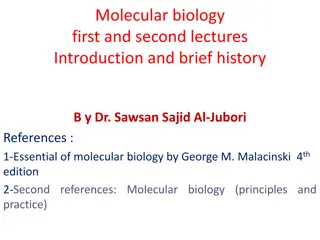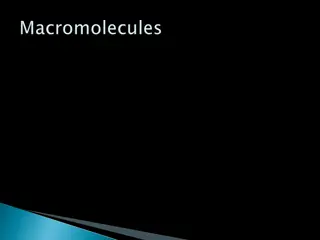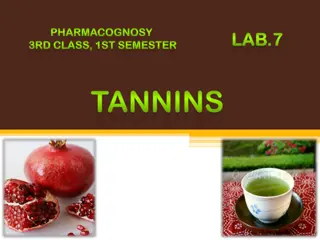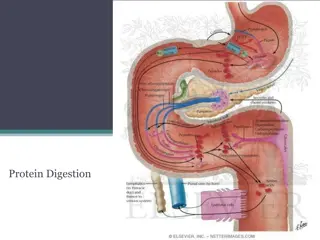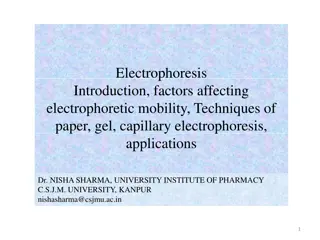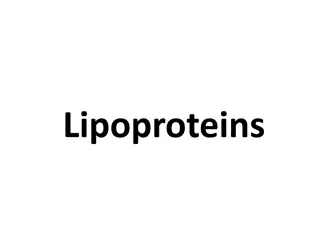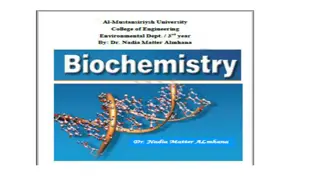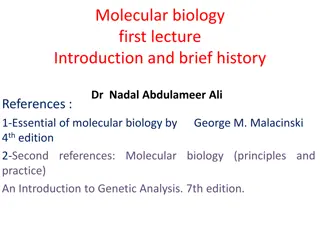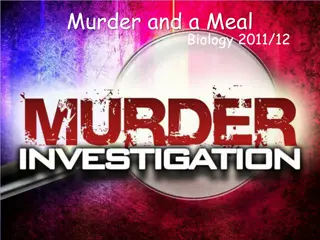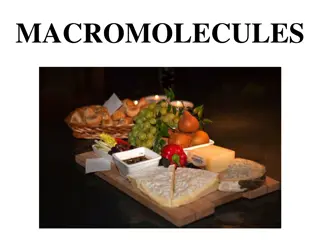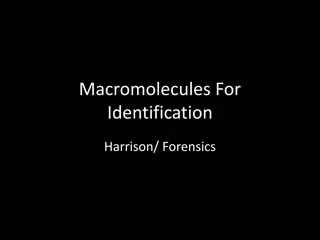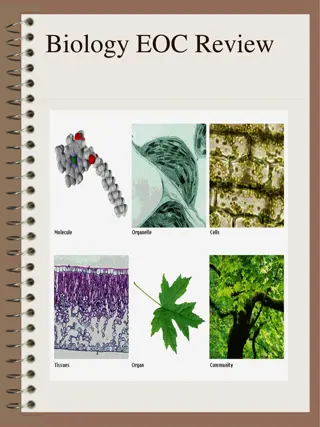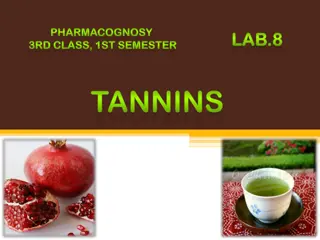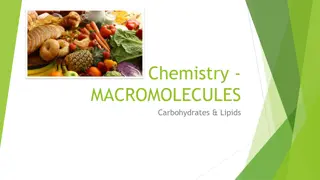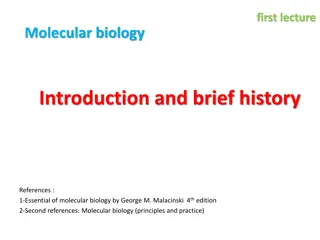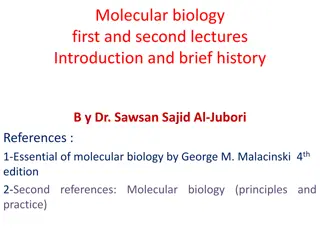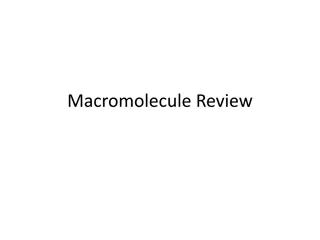Understanding Extracellular Matrix (ECM) and Its Functions
Extracellular Matrix (ECM) is a complex network of proteins, glycoproteins, and macromolecules that provide structural support, regulate cell activities, and play crucial roles in various tissues. It consists of two main types - interstitial matrix and basement membrane, each serving specific functi
12 views • 25 slides
History of Molecular Biology: Key Experiments and Discoveries
This content covers the introduction and brief history of molecular biology, highlighting key experiments such as the work of Freidrich Miescher, Griffith's transformation experiment, and Avery-MacLeod-McCarty's proof of DNA as the genetic material. It explores the early understanding of macromolecu
1 views • 17 slides
Understanding Glandular Epithelium and Secretory Cells
Glandular epithelium consists of epithelial cells specialized in producing and secreting various macromolecules, found in glands throughout the body. These secretory cells can synthesize proteins, lipids, and carbohydrates, with different types of glands such as exocrine and endocrine glands. The se
0 views • 13 slides
Understanding Living Things: An Overview of Classification
Living things share common characteristics like being made of cells, responding to the environment, and reproducing. Macromolecules in cells help them function, and unicellular and multicellular organisms differ in structure. The levels of organization in multicellular organisms are explained, along
0 views • 18 slides
Understanding Carbohydrates in Living Organisms
Carbohydrates, along with proteins, lipids, and nucleic acids, are essential macromolecules in living organisms. They are made up of carbon, hydrogen, and oxygen in a 1:2:1 ratio. Carbohydrates provide the main energy source for living things, with examples including glucose, fructose, and sucrose.
0 views • 58 slides
Understanding Tannins: Properties, Uses, and Structures in Pharmacognosy
Tannins, complex phenolic glycosides found in plants, have various properties such as water solubility and ability to precipitate proteins. They are important for their astringency and therapeutic uses in tanning, treating burns, and as antioxidants. The interaction of tannins with macromolecules is
3 views • 18 slides
Understanding Protein Digestion and Amino Acid Metabolism
The process of protein digestion involves proteolytic enzymes produced by the stomach, pancreas, and small intestine. Pepsinogen is activated to pepsin in the stomach, breaking down proteins into oligopeptides and amino acids. After absorption, amino acids are utilized for protein synthesis and as d
0 views • 7 slides
Understanding Chemical Groups and Macromolecules in Biological Processes
In biological processes, certain chemical groups play crucial roles in molecular functions. These functional groups, including hydroxyl, carbonyl, carboxyl, amino, sulfhydryl, phosphate, and methyl, are essential for the structure and function of biological molecules. Additionally, macromolecules, s
0 views • 9 slides
Understanding Electrophoresis: Principles, Techniques, and Applications
Electrophoresis is a technique dating back to principles of electrochemistry, involving the movement of charged particles in an electric field for separation. Factors affecting electrophoretic mobility include charge, particle size, shape, and applied electrical field. Techniques such as paper, gel,
0 views • 22 slides
Understanding Lipoproteins: Structures and Functions
Lipoproteins are compound lipids formed by the aggregation of neutral and amphipathic lipids with proteins (apoproteins). They serve as vehicles for transporting lipids through the bloodstream and lymphatic system, acquiring polarity due to their hydrophilic properties. These macromolecules are synt
0 views • 51 slides
Understanding the Molecular Composition of Living Cells
Living cells are primarily composed of hydrogen, oxygen, nitrogen, carbon, phosphorus, and sulfur, which form the basis of organic biomolecules. Cells have common features such as cytoplasm, cell membranes, and nuclei. Different types of cells exist, ranging from eukaryotic with organized nuclei to
0 views • 9 slides
Introduction to Molecular Biology: Historical Insights and Key Experiments
Molecular biology is a field that focuses on understanding the behaviors of macromolecules like DNA, RNA, and proteins. This summary discusses the history of molecular biology, including the work of Friedrich Miescher and Griffith's experiment, which demonstrated the transfer of genetic material. Th
0 views • 19 slides
Murder and a Meal: Investigation of a Mysterious Crime Through Macromolecules
In the city of Fresno, a murder has taken place, and biology students from Bullard High School are tasked with assisting in the investigation. By analyzing the victim's stomach contents from different eateries like Me-n-Ed's Pizzeria, World Sports Cafe, and Ovidio's Restaurante, they aim to determin
0 views • 20 slides
Understanding Macromolecules and Energy from Food
Explore the world of macromolecules, including carbohydrates, lipids, proteins, and nucleic acids, and learn how these large molecules are formed from smaller units. Discover the role of carbohydrates in providing energy, digestion, and absorption, and delve into the different types of carbohydrates
0 views • 9 slides
Understanding Macromolecules in Forensics and Biology
All living organisms contain essential organic macromolecules - lipids, proteins, carbohydrates, and nucleic acids - composed of carbon, hydrogen, oxygen, and other elements. These macromolecules serve vital functions in cellular processes and structure, with carbohydrates providing energy sources a
0 views • 19 slides
Understanding Key Concepts in Biology and Chemistry
Exploring the fundamentals of biology and chemistry, including methods for problem-solving, characteristics of life, organic compounds in organisms, and the role of enzymes in metabolism. Learn about cellular organization, reproduction, metabolism, homeostasis, heredity, response to stimuli, growth
0 views • 21 slides
Understanding Organic Chemistry and Macromolecules
Organic chemistry focuses on compounds with carbon bonds, while inorganic chemistry deals with other compounds. Carbon is unique due to its ability to form multiple bonds, creating diverse structures like chains and rings. Organic compounds, produced by living organisms, range from simple to complex
0 views • 32 slides
Understanding Tannins in Pharmacognosy: Properties, Structure, and Uses
Tannins are phenolic compounds found in plants, known for their complex nature and diverse properties. They are soluble in various solvents, play a role in tanning leather, and have medicinal uses such as treating burns and acting as antioxidants. The interaction between tannins and macromolecules i
0 views • 18 slides
Gel Electrophoresis in Genetic Engineering: Principles and Types
Gel electrophoresis is a crucial technique in genetic engineering used to separate macromolecules based on size and charge. Agarose and polyacrylamide gels are the two main types used, each with its advantages and disadvantages. Agarose gel electrophoresis is effective for separating large DNA molec
0 views • 14 slides
Understanding Gel Filtration Chromatography: Principles and Applications
Gel filtration chromatography is a molecular size-based separation technique used to separate macromolecules of different sizes. This method, also known as gel permeation or size exclusion chromatography, utilizes a porous stationary phase where small molecules penetrate all pores and are retained,
1 views • 10 slides
Understanding Carbohydrates and Lipids in Macromolecules
Explore the world of carbohydrates and lipids, essential macromolecules in chemistry. Carbohydrates provide energy and are found in foods like fruits, bread, and pasta, while lipids like fats play a crucial role in storing excess energy. Discover the types of carbohydrates, digestion processes, and
0 views • 16 slides
Exploring Molecular Biology: History and Key Experiments
Delve into the world of molecular biology through a historical journey, from Friedrich Miescher's discovery of nucleic acids to Griffith's groundbreaking experiments on genetic transformation. Witness the pivotal Avery-MacLeod-McCarty experiment that solidified DNA as the genetic material. Uncover t
0 views • 16 slides
History and Significance of Molecular Biology Discoveries
Introduction to molecular biology focusing on key historical breakthroughs such as the identification of nucleic acids by Friedrich Miescher, Griffith's experiment on genetic material transfer in bacteria, and the Avery-MacLeod-McCarty experiment proving DNA as the genetic material. These pivotal mo
0 views • 19 slides
Understanding Biomarkers and Toxicity Mechanisms: Overview of Mechanisms in Targeting Biological Macromolecules
This overview delves into different categorizations of mechanisms of action (MoA) based on target molecules, interaction types, and steric specificity. It explores non-specific and specific mechanisms, along with possible categorizations involving membrane toxicity, reactive toxicity, and species-sp
0 views • 8 slides
Exploring Macromolecules in Biology: Structures, Functions, and Interactions
Dive into the world of macromolecules through visual aids and questions that cover topics such as glycogen storage, steroid structures, energy storage in plants, carbohydrate reactions, molecule matching, and nucleic acid bases.
0 views • 7 slides
Understanding Macromolecules and Essential Nutrients for Overall Well-being
Learn about the main types of macromolecules - Carbohydrates, Lipids, Proteins, and Nucleic Acids - and how they contribute to our health. Explore the importance of essential nutrients available in everyday foods for growth and overall well-being, including carbohydrates, fats, proteins, vitamins, a
0 views • 31 slides

